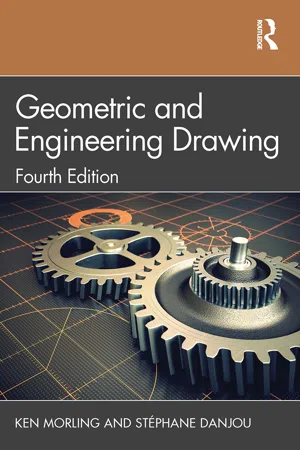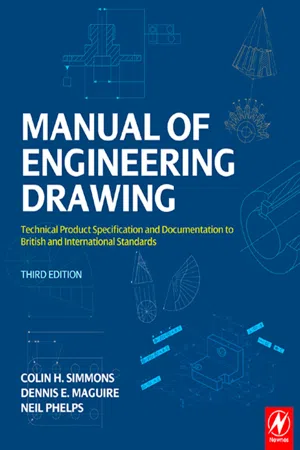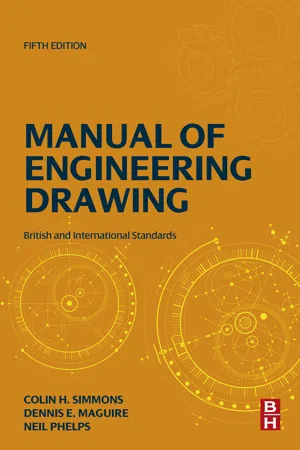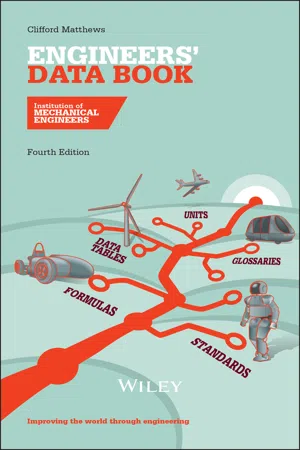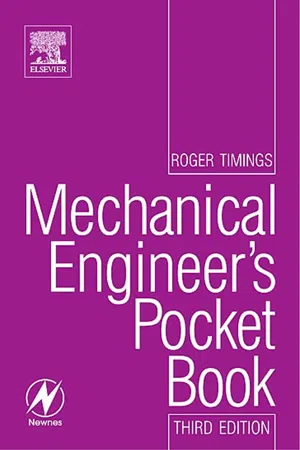Technology & Engineering
Dimensioning
Dimensioning is the process of defining and specifying the measurements and geometric characteristics of an object or part. It involves indicating the size, shape, and location of features on a technical drawing or 3D model using standardized symbols and conventions. Proper dimensioning is crucial for ensuring accurate manufacturing and assembly of components.
Written by Perlego with AI-assistance
Related key terms
Related key terms
1 of 4
Related key terms
1 of 3
7 Key excerpts on "Dimensioning"
- eBook - ePub
Manual of Engineering Drawing
Technical Product Specification and Documentation to British and International Standards
- Colin H. Simmons, Dennis E. Maguire(Authors)
- 2012(Publication Date)
- Butterworth-Heinemann(Publisher)
Chapter 16
Dimensioning Principles
A drawing should provide a complete specification of the component to ensure that the design intent can be met at all stages of manufacture. Dimensions specifying features of size, position, location, geometric control, and surface texture must be defined and appear on the drawing once only. It should not be necessary for the craftsman either to scale the drawing or to deduce dimensions by the subtraction or addition of other dimensions. Double Dimensioning is also not acceptable.Theoretically any component can be analysed and divided into a number of standard common geometrical shapes such as cubes, prisms, cylinders, and parts of cones. The circular hole in Fig. 16.1 can be considered as a cylinder through the plate. Dimensioning a component is the means of specifying the design intent in the manufacture and verification of the finished part.FIGURE 16.1A solid block with a circular hole in it is shown in Fig. 16.1 and to establish the exact shape of the item we require to know the dimensions which govern its length, height, and thickness, and also the diameter and depth of the hole and its position in relation to the surface of the block. The axis of the hole is shown at the intersection of two centre lines positioned from the left-hand side and the bottom of the block and these two surfaces have been taken as datums. The length and height have also been measured from these surfaces separately – this is a very important point as errors may become cumulative, and this is discussed later in the chapter.Dimensioning therefore should be undertaken with a view to defining the shape or form and overall size of the component carefully, and also the sizes and positions of the various features, such as holes, counterbores, and tappings from the necessary datum planes or axes.The completed engineering drawing should also include sufficient information for the manufacture of the part. This involves the addition of notes regarding the materials used, tolerances of size, limits and fits, surface finishes, the number of parts required, and any further comments which result from a consideration of the use to which the completed component will be put. For example, the part could be used in sub-assembly and notes would then make reference to associated drawings or general assemblies. - eBook - ePub
- Ken Morling, Stéphane Danjou(Authors)
- 2022(Publication Date)
- Routledge(Publisher)
Chapter 7 DimensioningDOI: 10.1201/9781003001386-77.1 INTRODUCTION
In contrast to pictorial representations in user manuals, spare part catalogues and assembly instructions, an engineering drawing is not an illustration. An engineering drawing, or technical drawing, differs from a technical illustration in that it is strongly regularised by standards and represents a detailed specification of the size and shape of a single part or of an assembly. The subjects of interest are the dimensions and associated tolerances.When an engineering drawing is made, Dimensioning is of vital importance. All the dimensions necessary to manufacture a part must be on the drawing and they must be presented so that they can be easily read, easily found and not open to misinterpretation. A neat drawing can be spoilt by bad Dimensioning.The principles for presentation of dimensions that apply to any kind of 2D engineering drawing is internationally standardised in ISO 129–1. National standards may differ from the given conventions.Figure 7.1 explains the structure of dimensions in engineering drawings. In general, dimensions consist of a dimension line, extension lines and a dimension value. This applies to linear dimensions and angular dimensions as well. An extension line is sometimes also referred to as a projection line and represents an extension of a feature outline or centre line. Extension lines indicate the starting and end point of a dimension. They are drawn as narrow continuous lines and extend from the outline to approximately 2 mm past the dimension line. While according to international standards the extension line shall touch the outline or feature to which it refers, Anglo-American standards require a visible gap between them. The dimension line shall be a narrow line according to ISO 128–2 (compare Chapter 2 ) and terminate with filled arrowheads as long as the letter height (usually 3.5 mm), and these arrowheads must touch the extension lines from the inside, as can be seen in Figure 7.2 (a) - eBook - ePub
Manual of Engineering Drawing
Technical Product Specification and Documentation to British and International Standards
- Colin H. Simmons, Dennis E. Maguire(Authors)
- 2009(Publication Date)
- Butterworth-Heinemann(Publisher)
Chapter 14. Dimensioning principles A drawing should provide a complete specification of the component to ensure that the design intent can be met at all stages of manufacture. Dimensions specifying features of size, position, location, geometric control and surface texture must be defined and appear on the drawing once only. It should not be necessary for the craftsman either to scale the drawing or to deduce dimensions by the subtraction or addition of other dimensions. Double Dimensioning is also not acceptable. Theoretically any component can be analysed and divided into a number of standard common geometrical shapes such as cubes, prisms, cylinders, parts of cones, etc. The circular hole in Fig. 14.1 can be considered as a cylinder through the plate. Dimensioning a component is the means of specifying the design intent in the manufacture and verification of the finished part. Fig. 14.1 A solid block with a circular hole in it is shown in Fig. 14.1 and to establish the exact shape of the item we require to know the dimensions which govern its length, height, and thickness, also the diameter and depth of the hole and its position in relation to the surface of the block. The axis of the hole is shown at the intersection of two centre lines positioned from the left-hand side and the bottom of the block and these two surfaces have been taken as datums - eBook - ePub
- K. L. Richards(Author)
- 2020(Publication Date)
- CRC Press(Publisher)
The requirement of a drawing is to provide a complete specification of the part ensuring the design will meet all stages of manufacture. Dimensions are essential to specify all features of size, position, geometric control and surface texture required for the part to meet its intended purpose. It should not be necessary for the craftsman to either scale the drawing or deduce any dimensions by the addition or subtraction of other dimensions to determine the position of the feature.It is important to understand that each dimension stated on the drawing is not an absolute value and will contain some degree of error. The amount of error that is allowable is a decision that has to be made by the designer. The amount of error that is allowable is indicated on the drawing by either a general note or a tolerance applied to individual dimensions (see Section 1.9 for more details of drawing tolerances). As the acceptable tolerance becomes smaller, there will be an impact on the increase in the cost of manufacture.There are a number of Dimensioning methods used to describe size requirements. These methods are discussed in the following sections. - eBook - ePub
Manual of Engineering Drawing
British and International Standards
- Colin H. Simmons, Dennis E. Maguire, Neil Phelps(Authors)
- 2020(Publication Date)
- Butterworth-Heinemann(Publisher)
A drawing should provide a complete specification of the component to ensure that the design intent can be met at all stages of manufacture. Dimensions specifying features of size, position, location, geometric control, and surface texture must be defined and appear on the drawing once only. It should not be necessary for the craftsperson either to scale the drawing or to deduce dimensions by the subtraction or addition of other dimensions. Double Dimensioning is also not acceptable.Theoretically any component can be analyzed and divided into a number of standard common geometrical shapes such as cubes, prisms, cylinders, and parts of cones. The circular hole in Fig. 16.1 can be considered as a cylinder through the plate. Dimensioning a component is the means of specifying the design intent in the manufacture and verification of the finished part.A solid block with a circular hole in it is shown in Fig. 16.1 and to establish the exact shape of the item we require to know the dimensions which govern its length, height, and thickness, and also the diameter and depth of the hole and its position in relation to the surface of the block. The axis of the hole is shown at the intersection of two center lines positioned from the left-hand side and the bottom of the block and these two surfaces have been taken as datums. The length and height have also been measured from these surfaces separately – this is a very important point as errors may become cumulative, and this is discussed later in the chapter.Fig. 16.1 Dimensioning of a hole.Dimensioning therefore should be undertaken with a view to defining the shape or form and overall size of the component carefully, and also the sizes and positions of the various features, such as holes, counterbores, and tappings from the necessary datum planes or axes.The completed engineering drawing should also include sufficient information for the manufacture of the part. This involves the addition of notes regarding the materials used, tolerances of size, limits and fits, surface finishes, the number of parts required, and any further comments which result from a consideration of the use to which the completed component will be put. For example, the part could be used in sub-assembly and notes would then make reference to associated drawings or general assemblies. - eBook - ePub
- Clifford Matthews(Author)
- 2011(Publication Date)
- Wiley-Blackwell(Publisher)
tolerance is the allowable variation of a linear or angular dimension about its ‘perfect’ value. British Standard 8888: 2008 contains accepted methods and symbols.Figure 4.34.3 Toleranced DimensionsIn designing any engineering component it is necessary to decide which dimensions will be toleranced. This is predominantly an exercise in necessity – only those dimensions that must be tightly controlled, to preserve the functionality of the component, should be toleranced. Too many toleranced dimensions will increase significantly the manufacturing costs and may result in ‘tolerance clash’, where a dimension derived from other toleranced dimensions can have several contradictory values.Figure 4.44.4 General Tolerances It is a sound principle of engineering practice that in any machine design there will only be a small number of toleranced features. The remainder of the dimensions will not be critical.There are two ways to deal with this: first, an engineering drawing or sketch can be annotated to specify that a general tolerance should apply to features where no specific tolerance is mentioned. This is often expressed as ± 0.5 mm. Alternatively, the drawing can make reference to a ‘general tolerance’ standard such as BS EN 22768 which gives typical tolerances for linear dimensions as shown.4.5 Holes The tolerancing of holes depends on whether they are made in thin sheet (up to about 3 mm thick) or in thicker plate material. In thin material, only two toleranced dimensions are required:- Size A toleranced diameter of the hole, showing the maximum and minimum allowable dimensions.
- Position
- eBook - ePub
- Roger Timings(Author)
- 2005(Publication Date)
- Newnes(Publisher)
7Linear and Geometric Tolerancing of Dimensions
7.1 Linear tolerancing
7.1.1 Limits and fits
It is not possible to work to an exact size nor is it possible to measure to an exact size. Therefore dimensions are given limits of size. Providing the dimensions of a part lie within the limits of size set by the designer, then the part will function correctly. Similarly the dimensions of gauges and measuring equipment are given limits of size. As a general rule, the limits of size allocated to gauges and measuring instruments are approximately 10 times more accurate than the dimensions they are intended to check (gauges) or measure (measuring instruments).The upper and lower sizes of a dimension are called the limits and the difference in size between the limits is called the tolerance . The terms associated with limits and fits can be summarized as follows:•Nominal size : This is the dimension by which a feature is identified for convenience. For example, a slot whose actual width is 25.15 mm would be known as the 25- mm wide slot.•Basic size : This is the exact functional size from which the limits are derived by application of the necessary allowance and tolerances. The basic size and the nominal size are often the same.•Actual size : The measured size corrected to what it would be at 20°C.•Limits : These are the high and low values of size between which the size of a component feature may lie. For example, if the lower limit of a hole is 25.05 mm and the upper limit of the same hole is 25.15 mm, then a hole which is 25.1 mm diameter is within limits and is acceptable. Examples are shown in Fig. 7.1(a) .Figure 7.1 Toleranced dimensions (a) methods of tolerancing; (b) unilateral tolerance and (c) bilateral tolerance. Dimensions in mm. Engineering Fundamental: Timings: Elsevier (Newnes).•Tolerance : This is the difference between the limits of size. That is, the upper limit minus the lower limit. Tolerances may be bilateral or unilateral as shown in Fig. 7.1(b) and (c)
Index pages curate the most relevant extracts from our library of academic textbooks. They’ve been created using an in-house natural language model (NLM), each adding context and meaning to key research topics.
Explore more topic indexes
Explore more topic indexes
1 of 6
Explore more topic indexes
1 of 4

